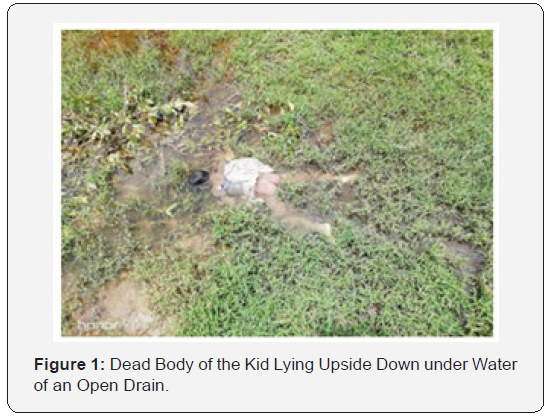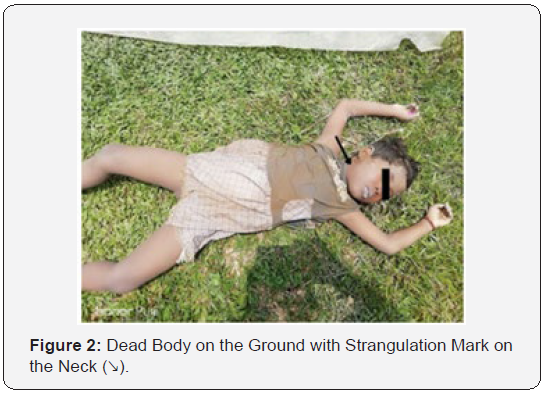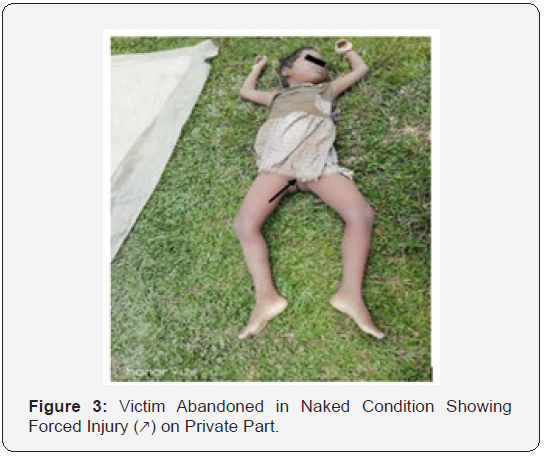Rape-Murder of A Kid – A Rare Case Report
Sabyasachi Nath* and HK Pratihari
Tripura State Forensic Science Laboratory, India
Submission:October 25, 2019; Published: November 06, 2019
*Corresponding author:Sabyasachi Nath, State Forensic Science Laboratory, Tripura, 799015, India
How to cite this article:Sabyasachi Nath, HK Pratihari. Rape-Murder of A Kid – A Rare Case Report. J Forensic Sci & Criminal Inves. 2019; 13(1): 555854. DOI: 10.19080/JFSCI.2019.13.555854.
Abstract
Sexual offence cases are increasing at an alarming rate in India in spite of the enforcement of stringent law like life imprisonment or death penalty to prohibit such crime. It appears that there is no more fear for committing such crime resulting rape victims are kid, teenager, minor and even old age group. In one case, a kid (6-year-old girl) was staying with parents near tea estate area. One day she was found missing and search was made but in vain. Subsequently missing report was registered in the local police station. On the following day, police got the information about detection of a dead body of a kid lying upside down in a drain with slowly running water. The police and forensic team immediately visited the undisturbed crime spot and could identify the kid with the help of local people/relative and further established to be the same missing kid registered in the police station. The dead body was sent for autopsy study after inquest by the police and collection of physical evidence along with photograph of the crime scene. In course of investigation, one strangulation mark was observed on the neck and injury on the private organ and it was suspected to be a case of rape-murder. Further, the input based on last seen theory from the locals could help to nail the suspect for matching evidence. The details have been discussed in this paper.
Keywords: Kidnap, Kid, Rape-murder, Heinous, Physical evidence, Autopsy report
Introduction
Rape is the fastest growing crime in the world and India is not an exception to it. As per National Crime Records Bureau (NCRB), MHA, Govt. of India report of the year 2011, it is known that every 20 minutes a woman is raped in India [1]. It is really an alarming figure but the conviction in the crime against women in India is reported to be 18.9% in the year 2015 as per the report of Indian Express [2]. In order to impose stringent rule, the Lok Sabha unanimously passed the protection of children from sexual offence amendment bill 2019 which seeks death penalty for aggravated sexual assault on children. The bill also defines child pornography and makes it punishable.
The causative factors for rape-murder are:
a) To satisfy lust and wipe out evidence by killing
b) Satisfy sadistic pleasure
c) Avoid victim’s evidence being raped
d) Kid is incapable to resist elderly person
e) Kid is unable to understand what is being done on her
f) Sudden fit of anger for threat perception
g) Escape stringent punishment under POCSO Act
h) Poor behavioural control
i) Devil overpowers for such heinous crime
In rape and murder cases, following issues need to be analyzed soon after the incident on undisturbed crime scene for collection of evidence to link victim, crime scene and potential suspect for successful investigation [3-6]:
a. Proper crime scene analysis and documentation
b. Photograph/sketch of crime scene/injuries on body including private parts
c. Post strangulation symptoms on rape victim
d. Photograph with scale of strangulation mark on the victim’s neck
e. Strangulating materials used
f. Wearing apparel of the victim and their condition
g. Footwear position of the victim/suspect on the crime spot and swabs be taken
h. Foot/shoe print on the spot for examination and comparison
i. Condom, if any, be swabbed separately from both inner and outer surfaces
j. Soil/pollen on the body/wearing apparel along with control sample
k. Blood stained soil along with control soil sample
l. Sign of dragging on the spot
m. Public hair of the rape victim/suspect on the spot/ garments
n. Autopsy of the victim by a team of medico-legal experts
o. Collection of biological evidence (vaginal/anal/oral swab/ pubic and scalp hair/blood etc.) by registered medical officer using sexual assault evidence collection kit (SAECK)
p. Nail clippings of the rape victim for examination of blood/ skin/tissue
q. Viscera/urine of the victim for drug/intoxicant analysis
r. Relevant biological samples, hair and wearing apparel of the suspect for examination/matching
s. Cell phone of victim/suspect for analysis of call records
t. Family history of the victim/suspect in details
Case Report
One kid (6-year-old girl) was staying with her parents near a tea estate area. One day the kid was last seen moving with some local boys as reported by the inhabitants of the area. Thereafter the kid did not return back home till late evening. Search was made by the parents and relatives but could not trace out her where about. Subsequently a missing report was registered in the local police station. The parents had sleepless night and on the following day search was continued. In the meantime, information was received by the police station about detection of a dead body lying upside down under water in an open drain. The body was identified as the same missing girl reported in the police station a few hours before detection. The inquest was made, and all physical evidence was collected before autopsy study.
Observation
The position of the deceased in this case of rape-murder, is shown in Figures 1-3.



Autopsy Findings
External
The deceased was about 6-year-old, 118 cm tall female kid. Mouth of the victim was open, both the eyes were open, eyeballs bulged out and softened, tongue protruded out, teeth intact, no injuries present over the inner aspect of lips and tongue. Coils of intestine extruded out through the external genitalia. Other natural orifices are intact. Nails are trimmed and no other foreign particles present over the body.
Internal
The skull and meninges are found intact, brain is liquefied. Dirty blackish colored mud present inside the lumen of larynx, trachea and bronchus, mucosa of which are congested. Both lungs are congested and softened. No abnormality was detected in other organs like diaphragm, ribs, chest wall, pericardial sac, large blood vessels, urinary bladder, urethra and uterus. Stomach contains 50gm of brownish colored paste like materials mixed with mud. The toxicological analysis of viscera and body fluid ruled out the presence of poison and drug in this case.
Injuries
One dark brown color non-continuous ligature mark having a maximum width of 2cm is transversely present on the mid part of front and sides of neck. It is absent in the back of neck for a distance of 8cm. On dissection, bruising is present within the layers of neck muscle. The hyoid bone, thyroid cartilage and cricoid cartilage are found intact. One lacerated wound measuring 2cmx0.5cmx0.2cm is present on the lateral wall of vulva on right side, surrounding area is congested. The vaginal orifice is spacious, hymen is ruptured at 9 o’clock, 6 o’clock and 3 o’clock positions. Lacerated wound measuring 2cmx1cmxfull thickness is present in the inferior wall of pouch of douglus through which coils of intestine are descending down and extruded out through the external genitalia. All the injuries are ante mortem in nature and fresh in duration at the time of death.
Conclusion
The rape-murder case is rarely reported and data on such crime head is not available in literature. But the rape-murder of a 6-year-old kid is the rarest of such rare cases. In this case, the criminal profile shows ruthless behavior towards the victim. The autopsy findings and critical analysis of the crime scene could help to reconstruct the criminal profile in this case. The accused in this case committed rape and due to poor behavioral control abandoned the victim inside drain flowing with muddy water. So, the place of detection of the victim is not the original place of crime and suggested to be somewhere else in the vicinity. The victim did not die just after strangulation but breathed last in the drain water resulting in presence of little muddy water in the trachea/bronchus as reported in the autopsy findings. Further, toxicological analysis of the body fluid of the victim ruled out presence of any intoxicants. As such, the death of the victim is contributed for strangulation and symptoms of partial drowning in this case. However, the body fluid of two potential suspects is under examination to match DNA evidence collected from the body of the kid to establish the crime and nab the criminal.
Acknowledgement
The authors are thankful to the autopsy surgeons for providing necessary documents to incorporate post-mortem findings and also to Mr. Rajib Sutradhar, Sub-Divisional Police Officer, Dharmanagar, for extending all possible supports for crime scene management.
References
- National Crime Records Bureau (2011) Ministry of Home Affairs, Government of India.
- National Crime Records Bureau (2015) Ministry of Home Affairs, Government of India.
- Fisher, Barry AJ(2004) Techniques of crime scene investigation. Seventh Edition, CRC Press LLC, Boca Raton.
- Becker, Ronald F (2009) Criminal Investigation. 3rd(), In: Jones & Bartlett Publishers, Sudbury, Massachusetts, USA.
- Nath S, Pratihari HK (2018) Gang Rape and Murder -A Case Report. J Forensic Sci& Criminal Inves 10(1): 1-4.
- Pratihari HK, Chakraborty SK, Nath S (2019) Forensic Investigation of a Rape, Sodomy and Murder Case.J Forensic Sci& Criminal Inves 12(2): 1-4.






























